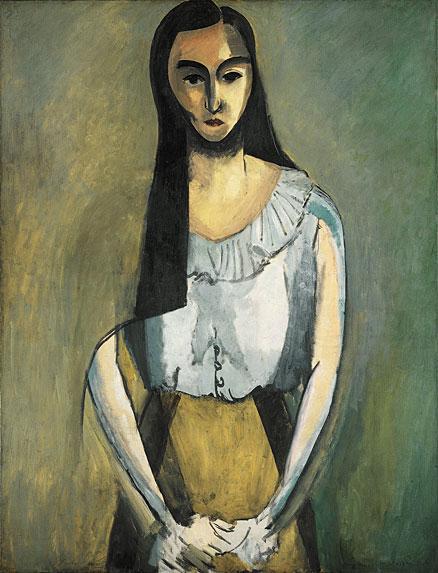Henri Matisse Gallery
Henri Matisse often painted the same subject in versions that range from relatively realistic to more abstract or schematic. At times the transition from realism to abstraction could be enacted in a single canvas, as is the case with The Italian Woman, the first of many portraits Matisse painted of a professional Italian model named Laurette. The purposefully visible pentimenti and labored convergence of lines bear witness to his perpetual struggle “to reach that state of condensation of sensations which constitutes a picture.” Matisse was not interested in capturing momentary impressions; he strove to create an enduring conception.
From the earlier state of the portrait, which depicts a heavier woman, Matisse pared down Laurette’s image, in the process making her less corporeal and more ethereal. Using the conventions of religious painting—a frontal pose, introspective countenance, and flat back-ground devoid of any indication of location—he created an icon of Woman. The emphatic eyes and brow, elongated nose, and pursed lips of her schematic face resemble an African mask, implying that Matisse, like so many Modern artists, equated the idea of Woman with the foreign, exotic, and “primitive”; he continued in this vein, posing the same model with a turban and a mantilla.
The spatial ambiguity of this portrait—the way the arms appear flat while the background overtakes a shoulder, for example—reveals Matisse’s relationship to Paul Cézanne via the bolder experiments of Cubism [more]. In a 1913 portrait of his wife, Matisse had played with the distinctions between volume and plane by including a flattened scarf that wraps around her arm. This treatment anticipates the shawl-like background of The Italian Woman. These paintings recall Cézanne’s series of portraits of Madame Cézanne (one of which was owned by Matisse) both formally and iconographically, although Matisse’s images are more radically schema-tized and distilled.
The austerity of color and severe reduction of The Italian Woman is characteristic of Matisse’s work from 1914 to 1918. The art historian Pierre Schneider has suggested that these elements embody the artist’s response to the devastation of World War I.
http://digitalconsciousness.net/top sites/?iy=317

viewer |
|
|
| Bathers by a River |
Italian Woman |
| Dance |
| Promenade among the Olives |
| Butterfly Net |
| Carmelina |
| Abduction of Europa |
| Seance du Matin |
Biography
Bulletin Board
Renowned Art
(home)
Matisse was the leader of the Fauvist (meaning Wild Beasts) Movement, a painting style which focused on pure colors used in an aggressive and direct manner. His style changed many times over the years, but he never gave up his art. Matisse continued creating even into his 80's, when cancer had taken over his body. This was the time when he created the papercuttings that he is perhaps best known for. Matisse understood perfectly the relationship between color and shape, a talent which rightfully earned him the name "Master of Color."
all artists, with thumbnails: by birth year | alphabetically
all artists: by birth year | alphabetically
artists born in the 13th 14th 15th 16th 17th 18th 19th 20th century